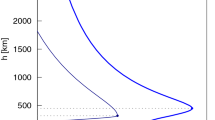Abstract
The majority of navigation satellites receivers operate on a single frequency and experience a positioning error due to the ionospheric delay. This can be compensated for using a variety of approaches that are compared in this paper. The study focuses on the last solar maximum. A 4D tomographic imaging technique is used to map the ionospheric electron density over the European region during 2002 and 2003. The electron density maps are then used to calculate the excess propagation delay on the L1 frequency experienced by GPS receivers at selected locations across Europe. The excess delay is applied to correct the pseudo-range single frequency observations at each location and the improvements to the resulting positioning are calculated. The real-time tomographic technique is shown to give navigation solutions that are better than empirical modelling methods and approach the accuracy of the full dual-frequency solution. The improvements in positioning accuracy vary from day to day depending on ionospheric conditions but can be up to 25 m during mid-day during these solar maximum conditions at European mid-latitudes.









Similar content being viewed by others
References
Ashby N, Spilker JJ (1995) Introduction to relativistic effects on the global positioning system. In: Spilker JJ, Parkinson BW (eds) Global positioning system: theory and applications, vol 1. AIAA, pp 623–697
Bilitza D (2001) IRI 2000. Radio Sci 36(2):261–276
Bust GS, Mitchell CN (2008) History, current state, and future directions of ionospheric imaging. Rev Geophys 46
Dear RM (2007) Wide area forecasting of total electron content over europe. PhD Thesis, University of Bath
Dow JM, Neilan RE, Gendt G (2005) The international GPS service: celebrating the 10th anniversary and looking to the next decade. Adv Space Res 36:320–326
Hernández-Pajares M, Juan JM, Sanz J (2000) Application of ionospheric tomography to real-time GPS carrier-phase ambiguities resolution, at scales of 400-1000 km and with high geomagnetic activity. Geophys Res Lett 27:2009–2012
Klobuchar JA (1987) Ionospheric time-delay algorithm for single-frequency gps users. IEEE Trans Aerospace Electron Syst AES 23(3):325–331
Klobuchar JA (1996) Ionospheric effects on GPS. In: Spilker JJ, Parkinson BW (eds) Global positioning system: theory and applications, vol 1. AIAA, pp 485–515
Kouba J, Héroux P (2001) Precise point positioning using IGS orbit and clock products. GPS Solut 5(2):12–28
Mannucci A, Iijima B, Lindqwister U, Pi X, Sparks L, Wilson B (1999) GPS and ionosphere. In: Stone WR (ed) Review of radio science 1996–1999. Oxford University Press, Oxford, pp 625–665
Meggs RW, Mitchell CN (2006) A study into the errors in vertical total electron content mapping using gps data. Radio Sci 41
Mitchell CN, Spencer PSJ (2003) A three dimensional time-dependent algorithm for ionospheric imaging using GPS. Ann Geophys 46(4):687–696
Parkinson BW (1996) GPS error analysis. In: Spilker JJ, Parkinson BW (eds) Global positioning system: theory and applications, vol 1. AIAA, pp 469–483
Schenewerk M (2003) A brief review of basic GPS orbit interpolation strategies. GPS Solut 6(4):265–267
Schmid R, Steigenberger P, Gendt G, Ge M, Rothacher M (2007) Generation of a consistent absolute phase-center correction model for gps receiver and satellite antennas. J Geod 81(12):781–798
Spencer PSJ, Mitchell CN (2007) Imaging of fast moving electron-density structures in the polar cap. Ann Geophys 50(3):427–434
Spilker JJ (1994) Tropospheric effects on GPS. In: Spilker JJ, Parkinson BW (eds) Global positioning system: theory and applications, vol 1. AIAA, pp 517–546
Acknowledgments
We are grateful to the International GNSS Service (IGS) and EUREF for the GPS observation data and again to the IGS for the GPS precise ephemeris. We acknowledge the use of the International Reference Ionosphere (IRI) model and of the National Geophysical Data Center (NGDC) coastline data. We acknowledge the participation of Andrew Brown of the University of Southampton.
Author information
Authors and Affiliations
Corresponding author
Additional information
This project was funded by the EPSRC.
Rights and permissions
About this article
Cite this article
Allain, D.J., Mitchell, C.N. Ionospheric delay corrections for single-frequency GPS receivers over Europe using tomographic mapping. GPS Solut 13, 141–151 (2009). https://doi.org/10.1007/s10291-008-0107-y
Received:
Accepted:
Published:
Issue Date:
DOI: https://doi.org/10.1007/s10291-008-0107-y



